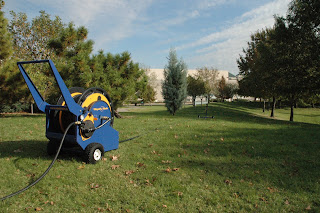| Home and Garden Tips Lawn and Garden Care Rules of Thumb for Water Use on Lawns and Gardens - One deep watering is much better than watering several times lightly.
- Lawns need about 1 inch of water each week. If the weather is very hot, apply an inch of water about every 3 days.
- Watering to a depth of 4-6 inches encourages deeper, healthier root development. It allows longer periods between watering.
- To measure the water, put an empty tuna can (or cat food can) on the lawn while watering. Stop watering when the can is full or if you notice water running off the lawn.
Know Your Soil Different soil types have different watering needs. You don't need to be a soil scientist to know how to water your soil properly. These tips can help. - Loosen the soil around plants so it can quickly absorb water and nutrients.
- Use a 1- to 2-inch protective layer of mulch on the soil surface above the root area. Cultivating and mulching reduce evaporation and soil erosion.
- Clay soil: Add organic material such as compost or peat moss. Till or spade to help loosen the soil. Since clay soil absorbs water very slowly, water only as fast as the soil absorbs the water.
- Sandy soil: Add organic material to supplement sandy soil. Otherwise, the water can run through it so quickly that plants won't be able to absorb it.
- Loam soil: The best kind of soil. It's a combination of sand, silt, and clay. Loam absorbs water readily and stores it for plants to use.
Water at the Right Time of the Day - Early moring or night is the best time for watering to reduce evaporation.
- To help control where your water goes, water when it's not windy.
Rules of Thumb for Proper Fertilizer Use Fertilizers provide nutrients necessary for plant health and growth, such as nitrogen, phosphorus, and potassium. These are what N, P, and K stand for on bags of fertilizer. Nitrogen (N) is needed for healthy green growth and regulation of other nutrients. Phosphorus (P) helps proper roots and seeds develop and resist disease. Potassium (K) is also important in root development and disease resistance. When properly applied, the nutrients in fertilizers are absorbed by plants and little of these nutrients enters ground or surface water resources. Use the Right Fertilizer - Test your soil to find out what nutrients ar needed. Contact your local Natural Resources Conservation Service or Cooperative State Research, Education, and Extention Service office to get information on obtaining a soil test. Local fertilizer dealers can also be helpful.
- A soil test will help you understand what your plants require.
- Follow label directions.
- Choose a fertilizer that has at least one-fourth of the nitrogen in a slow-release form, such as sulpher-coated urea.
Mow Your Lawn Frequently Leave the grass clippings to decompose on the lawn. Annually, this will provide nutrients equivalent to one or two fertilizer applications. Set mower at 2 inches to reduce water use during hot weather. Apply Fertilizer Properly - It is best to apply fertilizer when the soil is moist and then water lightly. This will help the fertilizer move into the root zone where it is available to the plants, rather than stay on top of the soil where it can be blown or washed away.
- Watch the weather. Avoid applying it immediately before a heavy rain system is predicted to arrive. Too much rain (or sprinkler water) will take the nutrients away from the lawn's root zone.
- Use the minimal amount of fertilizer necessary and apply it in small, frequent applications. An application of 2 pounds of fertilizer five times per year is better than 5 pounds of fertilizer twice a year.
- Calibrate your fertilizer spreader to be sure you know exactly how much material is being discharged in a given space. Follow instructions accompanying your spreader.
- When spreading fertilizer, cover ends of the lawn first, ten go back and forth across the rest of the lawn, using half of the recommended amount. Shut the spreader off before reaching the ends to avoik over-application. Apply the other half of the fertilizer going back and forth perpendicular to the first pattern.
- Dispose of fertilizer bags or containers in a safe and state-approved manner.
Alternatives to Pesticides and Chemicals When used incorrectly, pesticides can pollute water. They also kill beneficial as well as harmful insects. Natural alternatives prevent both of these events from occurring and save you money. Consider using natural alternatives for chemical pesticides: Non-detergent insecticidal soaps, garlic, hot pepper sprays, 1 teaspoon of liquid soap in a gallon of water, used dishwater, or forceful stream of water to dislodge insects. Also consider using plants that naturally repel insects. These plants have their own chemical defense systems, and when planted among flowers and vegetables, they help keep unwanted insects away. The table below contains a partial list of nature's alternatives. |


No comments:
Post a Comment